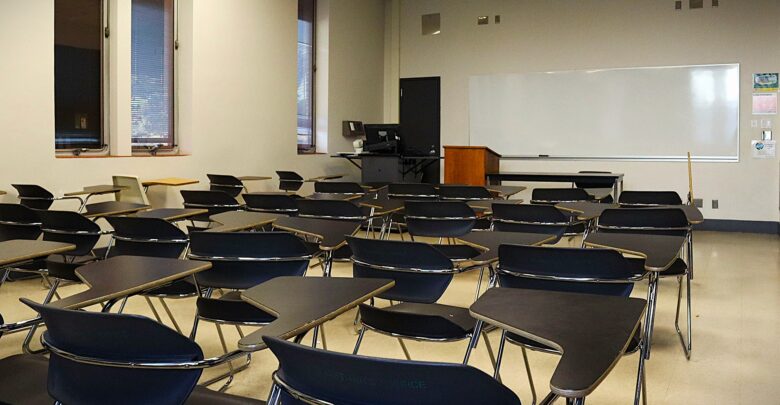U of A teachers share concerns about growing class sizes
How are increasing class sizes impacting professor workload and the student experience?
 Leah Hennig
Leah HennigThe University of Alberta wants to increase enrolment by 16,000 over the next 10 years. To achieve this goal, the university plans to welcome additional students per year going forward. But U of A professors and academic teaching staff (ATS) have begun to already notice their classes — and workload — increasing.
Gordon Swaters, a professor in the faculty of science and President of the Association of Academic Staff at the U of A (AASUA), has noticed such changes.
“Yes, the class sizes are increasing,” Swaters said. “I’m not opposed to increasing enrolment, but in my respectful view, that must be accompanied by more people teaching.”
“Who will teach the new 16,000 students the university is planning to bring in? It appears the [U of A] will be further relying on [ATS] instructors who are without job security.”
ATS instructors have a contract with the university for a certain period of time. Their position is different to those who are on track to be tenured, or are tenured.
Swaters added that ATS instructors currently have less time for course planning and less time to spend with students one-on-one, “meaning the student experience will be negatively impacted.”
According to U of A Media Relations, “class sizes are determined by faculty/instructors to meet the pedagogical requirements of the class, and the university administration does not dictate class size.”
A comment sent to The Gateway from the Office of the Dean of Faculty of Arts said that “the maximum enrolment for a course is normally determined at the level of the department or program area, and is subject to final approval by the dean’s office.”
A comment sent to The Gateway from the Office of the Dean of Faculty of Arts said that “the maximum enrolment for a course is normally determined at the level of the department or program area, and is subject to final approval by the dean’s office.”
On October 10, Maclean’s published a list of average class sizes by university. The list includes 43 universities across Canada and reflects the average size of undergraduate classes.
Ordered from smallest average class size to largest, the U of A ranked 31st in first and second-year class sizes. In third and fourth-year classes, the U of A ranked 30th.
Academic teaching staff share different experiences
Swaters said that when class sizes increase, the instructor sees not only more students, but an increase in their contract hours. However, their salary stays the same.
“My salary is the same if an additional student is in one of my classes. But it does mean [the U of A] gets increased revenue,” Swaters said.
The Gateway spoke to two U of A ATS members, who are kept anonymous because of job security concerns.
One said that when a class has 200 or 300 students, “it becomes hard to do things that should be a given,” such as emails, meetings, and marking assignments. Because they are an ATS member, they are “rarely, if ever, given teaching assistants (TA) or teaching support.”
“Smaller classes or teaching supports would make these things manageable when sometimes they just feel impossible,” they said.
The second ATS member shared their frustrations with increasing class sizes, especially when it comes to managing accommodations. In larger classes, it becomes harder to handle accommodations, they said.
“I want to support students — that’s critical — but it just becomes too much. There are just so many more emails, and there’s so much sideline prep [required] to offer support. And it becomes less individualized.”
“Increasing teaching loads on existing instructors has negative impacts on their scholarship,” Swaters says
Michael Frishkopf is a tenured professor in the department of music. Frishkopf explained that he typically teaches smaller classes.
“Small classes are much more flexible. I can give a lecture, but also adapt to students’ interests.”
Frishkopf feels that smaller classes also allow him to adapt to a student’s needs in a way that larger classes can’t. When he teaches larger classes, “it’s hard to get to know anyone, even names.”
Brian Fauteux is a tenured professor in the faculty of arts. Fauteux thinks that having a balance between large and small classes is important. However, Fauteux noted that increased class sizes have had a larger impact on smaller seminars.
“In the past I would have a seminar of seven or eight students and it would be no issue,” Fauteux said.
Fauteux explained that when looking for a room to teach a seminar, none were large enough to accommodate the current size of seminar classes. He explained that he has had to put more effort into finding a classroom than before.
“Over the last few years especially, I’ve spent some days just walking from building to building, to look at these rooms to see if they work.”
When it comes to workload, Fauteux feels he has an average workload compared to other colleagues at the university. However, he noted that there’s been an increase in tasks he wasn’t previously handling.
“I’ve noticed recently that there’s more work popping up in places that weren’t there before. Things that seem to fall outside of the research, teaching, and service breakdown of what the overall contract is,” Fauteux said. He attributes this to the effects of restructuring and feels his workload balance is “pretty good.”
One reason for why class sizes have been increasing recently could be attributed to the U of A being “driven by revenue considerations,” Swaters said.
“If you have smaller classes, then you must have more instructors — assuming you don’t increase teaching loads on instructors. But increasing teaching loads on existing instructors has negative impacts on their scholarship. It’s a vicious circle.”




